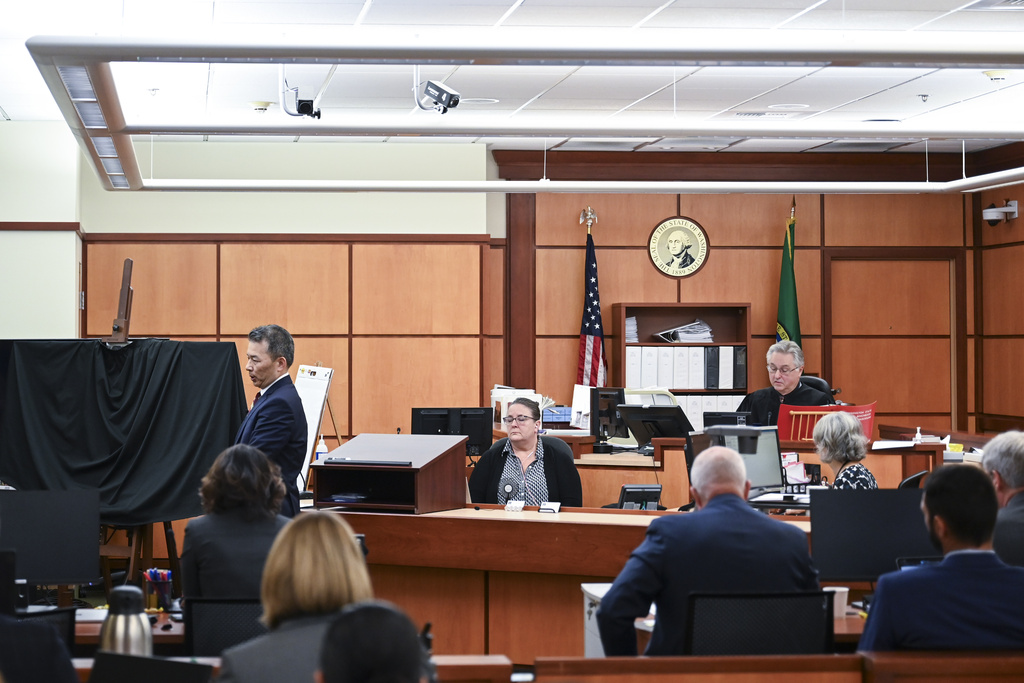TACOMA— A cellphone video of the 2020 fatal arrest of Manny Ellis shows the Black man on the ground with his hands in the air in surrender as police officers held his neck and shot him with a Taser, according to the testimony Wednesday of a forensic video analyst in the trial of three Washington officers accused in his death.
Prosecutors are also expected to call Ellis’ sister and mother to the stand.
Tacoma Officers Matthew Collins and Christopher Burbank, both white, are charged with second-degree murder and manslaughter. Officer Timothy Rankine, who is Asian American, is charged with manslaughter. All three have pleaded not guilty.
Video evidence will be key in the case against the officers. The officers have claimed that the 33-year-old Ellis aggressively fought back, but the videos show he was in a surrender position during the attack.
Grant Fredericks, owner of a forensic video analysis company, walked the jury, slide by slide, through one of the cellphone videos shot by a witness. It shows Collins on the ground behind Ellis with his hands near Ellis’ neck and Burbank standing in front holding a Taser.
Ellis’ arms are in the air.
“I can see fingers, palms and thumbs. We can see that both hands palms out, fingers spread apart,” Fredericks said. “Mr. Burbank is raising the Taser and directing it toward Mr. Ellis with his hands in the air.”
Seconds later, Burbank fires the Taser and Collins has his arm around Ellis’ neck. In the frames that follow, Ellis’ head drops to the ground.
“There’s no movement after that,” Fredericks said. Prosecutors have said that Collins’s restraint of Ellis rendered him unconscious.
Later frames show Ellis’ head moving up and Collins’ knee also moving up.
“I can’t say if there’s contact,” Fredericks said.
During opening statements Tuesday, prosecutors described the arrest as a deadly unprovoked beating, while defense lawyers said Ellis died because he was high and had a bad heart.
Assistant Attorney General Kent Liu told jurors that Collins and Burbank punched Ellis, took him to the ground, put him in a chokehold and shot him three times in the chest with a Taser. Liu said Rankine then put pressure on Ellis’ back while he was face down on the sidewalk.
“’Can’t breathe sir. Can’t breathe. Breathe sir. Still can’t breathe, sir.’ Those were the last known words of Manuel Ellis,” Liu told the jury.
Attorney Anne Bremner, representing Rankine, said Ellis died of “excited delirium” — brought on by drug use and causing him to have “superhuman” strength.
“Why would these officers do anything extreme if he wasn’t fighting, if he wasn’t suffering from excited delirium?” Bremner asked hypothetically.
Critics have called the term unscientific, rooted in racism and a way to hide police officers’ culpability in deaths. In March, the National Association of Medical Examiners took a stand against the term, saying it should not be listed as a cause of death.
The Pierce County Medical Examiner ruled the death a homicide and said it was caused by a lack of oxygen during the physical restraint. But Bremner read a line from Dr. Thomas Clark’s autopsy report, which said, “the extremely high meth concentration should be considered the primary factor.”



